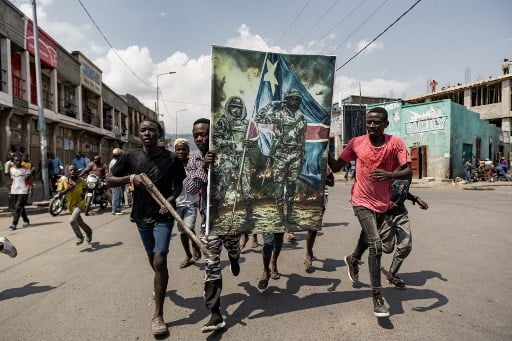Inside rebel territory: Treacherous trip to Kishishe ‘massacre’ grounds
Sunday January 15 2023
Residents of Kishishe in North Kivu, eastern DRC, which has been racked by violence. PHOTO | GATETE NYIRINGABO
We set out on an intricate clandestine journey which took us to Rutshuru in eastern Democratic Republic of Congo, to investigate alleged massacres reported in a village called Kishishe.
Before our visit, what had been painted to us was a horror picture of civilians killed by M23 rebels while they prayed in an Adventist church, which was later set on fire: Fifty killed on December 1, 100 on December 2, and 300 on December 5, all announced by various DRC government spokespersons.
They even declared three days of national mourning.
Read: 'Around 300' dead in DRC massacre
Meanwhile, the UN Mission, Monusco, reported 131 casualties, and added that women were raped and others abducted into sexual slavery — Boko Haram style.
Addressing the United Nations Security Council, Monusco boss Bintou Keita even called the council to “ask the immediate release of the survivors that are prevented from leaving the area held by the M23.”
All agreed, however, that they had not set foot in Kishishe, so their allegations were based on hearsay.
The “Kishishe massacres” were publicised a day after Alice Wairimu Nderitu, the UN Special Adviser on the Prevention of Genocide, issued a statement after a four-day visit to the DRC, raising the alarm that indicators of a genocide against the Banyamulenge were gradually falling into place.
So, a band of journalists who had done the Cabo Delgado expedition in Mozambique two years ago after Rwanda sent a stabilisation force to the troubled region got back together, this time for a mission deep into the DRC warzone.
Also read: In Mozambique’s war, allies Rwanda, TZ face some tricky odds
We got in touch with John* (not his real name), an M23 contact who lives in Kigali. John made a few calls and confirmed that M23 would arrange a safe passage for us in the Rutshuru territory, where all manner of militias are active.
After three days and nights of riding on pick-ups, motorbikes, walking on foot for about 30 kilometres, carrying Marc, our cameraman, and sleeping in trenches, we arrived in the small village at the entrance of the Virunga National Park.
As we entered Kishishe, our preconceptions started to dissipate. We found residents interacting with M23 rebels. The village was somewhat deserted, with people still returning after fleeing earlier.
Located in the middle of nowhere, with no electricity to charge cellphones, no radio signal, a four-classroom ramshackle school, no factors of production or distribution such as a market, a mill or livestock, and its subsistence farmers, unsuspecting of their overnight global fame.
This is what we learnt from Kishishe residents:
Nineteen people were killed during a brief battle between a local militia and M23 on November 29, 2022. Eight of them were residents, 11 were militiamen. The battle was sparked by an ambush, allegedly set up by FDLR and Mai-Mai, on the northern flank of the village.
No children and women were killed, and no cases of sexual violence and abduction, we were told.
So we sent a questionnaire to the Monusco and the DRC government asking: What are the names of the people who were killed? Where did you get your information?
Monusco replied, admitting that they did not know the identity of the victims. As for their findings, they added that they would assess the “opportunity to make them public,” taking into account the security of witnesses.
It is not the first time that “massacres” are invented in eastern DRC and broadcast by prominent figures and major news agencies, then disproved after investigation.
In the so-called “Kipupu Massacres” in South Kivu: the figure of 220 victims initially announced by provincial members of parliament, was taken up by Congolese politicians, then broadcast by international media. The number of victims was finally brought down to 15 after a joint Monusco–DRC government mission visited the site on July 29, 2020.
